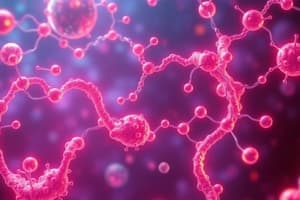Podcast
Questions and Answers
ما هو المسار الأيضي الذي ينتج الجلوكوز من المركبات غير السكرية؟
ما هو المسار الأيضي الذي ينتج الجلوكوز من المركبات غير السكرية؟
- البناء الهدمي
- التخمر اللاهوائي
- التنفس الخلوي
- البناء الحيوي (correct)
أي مسار أنابولي يحول الكربوهيدرات الزائدة إلى دهون؟
أي مسار أنابولي يحول الكربوهيدرات الزائدة إلى دهون؟
- البناء الضوئي
- التخمر اللاهوائي
- البناء الهدمي
- البناء الحيوي (correct)
أي من المسارات التالية تعتبر مسارًا أنابوليًا؟
أي من المسارات التالية تعتبر مسارًا أنابوليًا؟
- التنفس الخلوي
- البناء الضوئي (correct)
- البناء الهدمي
- التخمر اللاهوائي
ما هو المسار الذي يحول الجليكوجين إلى جلوكوز؟
ما هو المسار الذي يحول الجليكوجين إلى جلوكوز؟
أي من العمليات التالية تُعتبر مسارًا أنابوليًا؟
أي من العمليات التالية تُعتبر مسارًا أنابوليًا؟
ما هو المسار الأيضي المسؤول عن بناء مخزون الغليكوجين بعد فترات الرياضة الشاقة أو انخفاض مستويات السكر في الدم؟
ما هو المسار الأيضي المسؤول عن بناء مخزون الغليكوجين بعد فترات الرياضة الشاقة أو انخفاض مستويات السكر في الدم؟
ما هو المسار الأيضي المسؤول عن تكسير البروتينات إلى أحماض أمينية؟
ما هو المسار الأيضي المسؤول عن تكسير البروتينات إلى أحماض أمينية؟
ما هو المسار الأيضي المسؤول عن تخليق الدهون الثلاثية من الأحماض الدهنية؟
ما هو المسار الأيضي المسؤول عن تخليق الدهون الثلاثية من الأحماض الدهنية؟
ما هو المسار الأيضي الهدمي الذي يكسر الأحماض الدهنية إلى مكونات أصغر، مما ينتج عنه طاقة؟
ما هو المسار الأيضي الهدمي الذي يكسر الأحماض الدهنية إلى مكونات أصغر، مما ينتج عنه طاقة؟
ما هي العوامل التي تنظم عمليات البناء والهدم في الخلايا؟
ما هي العوامل التي تنظم عمليات البناء والهدم في الخلايا؟
لماذا من المهم فهم التفاعلات المعقدة بين عمليات البناء والهدم في الجسم؟
لماذا من المهم فهم التفاعلات المعقدة بين عمليات البناء والهدم في الجسم؟
Flashcards are hidden until you start studying
Study Notes
Metabolism and Anabolic Pathways
Introduction
Metabolism is the dynamic process occurring within a living cell, responsible for converting food into energy and building blocks for essential cellular functions. It involves two primary categories of pathways: catabolic and anabolic. Catabolic pathways refer to processes that break down larger molecules into smaller components to release energy, while anabolic pathways involve the synthesis of larger molecules from smaller ones. Both types of pathways are crucial for maintaining cellular function and supporting the life of an organism.
This article focuses on anabolic pathways, specifically those involved in storing excess energy and synthesizing triglycerides. These anabolic pathways play a vital role in providing the necessary energy reserves and building blocks for cellular growth and reproduction.
Glycolysis and Gluconeogenesis
Glycolysis is the catabolic pathway that breaks down glucose into pyruvate, releasing energy in the process. However, intermediates from this pathway can also be used to synthesize glucose through the anabolic pathway of gluconeogenesis. This process occurs when a cell is in positive energy balance, with excess carbohydrates being converted to fat or stored as glycogen.
Glycogenolysis and Glycogenesis
Glycogenolysis is the catabolic pathway that breaks down glycogen into its component glucose molecules, providing energy for cells. In contrast, glycogenesis is the anabolic pathway responsible for rebuilding glycogen stores after periods of heavy exercise or low blood sugar levels.
Proteolysis and Amino Acid Synthesis
Proteolysis is the catabolic pathway that breaks down proteins into amino acids, which are then released into the bloodstream. These amino acids can participate in various anabolic processes, such as protein synthesis during growth and tissue repair. Additionally, amino acids can serve as precursors or building blocks for other essential molecules within the body.
Lipogenesis and β-oxidation
Lipogenesis is the anabolic pathway responsible for synthesizing triglycerides from fatty acids. When a cell has an excess of food, including carbohydrates and lipids, some of these nutrients may be used in lipogenesis to store energy reserves. On the other hand, β-oxidation is the catabolic pathway that breaks down fatty acids into smaller components, releasing energy that powers other cellular processes.
Regulation of Anabolic Pathways
Anabolism and catabolism are regulated by several factors, including hormones (such as insulin and glucagon), substrate availability, and end-product levels. The concerted regulation of these pathways ensures that cells efficiently build macromolecules while avoiding unnecessary waste and energy consumption.
As part of maintaining overall health, understanding the complex interactions between catabolic and anabolic pathways is crucial. By knowing how these processes work together, we can better appreciate the complexity of living systems and make informed decisions about our diet, exercise, and lifestyle choices.
Studying That Suits You
Use AI to generate personalized quizzes and flashcards to suit your learning preferences.



